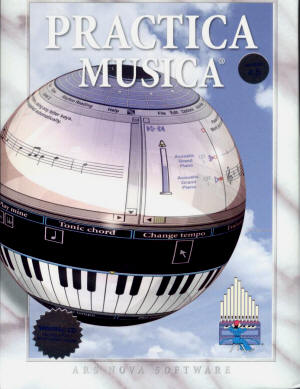|
|||
rs Nova's Practica Musica is a superior theory learning program which begins with very basic concepts and terminology, and then progresses all the way through seventh, ninth and altered chords, cadential resolutions, scales, keys, voicing, and musical forms, both simple and compound. Though user friendly and exceptionally well presented, it is definitely not for beginners or young children. On the contrary, it is suited for a college or university theory course, though mature students and adults working on their own should be able to navigate it comfortably as well. We would not recommend it for use as the main software program of a private teaching studio, but teachers are urged to try it out as a possible tool for their advanced students and even for themselves. A free download of movie clips demonstrating the features of Practica Musica is available from the Ars Nova website.
|
|||
|
Practica Musica is accompanied by a full-sized theory textbook some 3/4 of an inch thick, complete with copious examples, historical essays, and chapter summaries. The book could be used by itself with an ordinary piano. There are, in fact, exercises meant to be written on paper (in the Preface the author, Jeffrey Evans, notes, "Certain tasks, after all, are best done by hand.") According to Mr. Evans, "the program and book developed side-by-side." This is not to say, however, that the combination of printed text and computer software is awkward in any way. In fact, it is a pleasure to note that the two compliment, rather than imitate, each other: throughout the text, there are references to the corresponding screens which augment, illustrate, or offer appropriate activities and exercises for the matter at hand, while the activities menu follows closely the textbook chapters and headings. The format of the screen display is simple and consistent. There are more than eighty customizable activities, and in all of them the screen remains essentially the same: a five-octave keyboard at the bottom, plain or with letter names on the notes (a guitar fretboard may be substituted); the musical staff at the top, with directions and evaluations for each activity; and the various signs and symbols to be selected in the middle. Though no external keyboard is supplied, connecting a MIDI keyboard to your computer is not only compatible with the software but far more convenient, since all notation is generated on the staff directly from playing. Without it, one must place notes, accidentals and other signs on the staff with individual drags and drops of the mouse, plus some options on the computer keyboard. Practica Musica is a very sophisticated and well-organized learning tool. In its advanced stages it gets into two- and four-part composition, orchestra scoring, harmonic analysis (e.g., comparing Blues progressions to similar harmonic usage in Mozart), irregular accents and rhythmic patterns, and similar university-level matters which presuppose a fair amount of familiarity with the musical language. Some of the ear training exercises are ingeniously difficult, often with awkward intervals and tricky syncopations, and doing them correctly in tempo with a mouse is virtually impossible--a separate keyboard here is a must. The developer of the program indicates that "one needn't be limited to the mouse; the computer's letter keys are more suitable."
The last item in the Activities menu is
"Write Your Own Music", with submenus of 2-part, 4-part, 4-part with
symbols, Composition (free writing with treble and bass staves), and
Orchestra Writing (which can use multiple staves). The Composition
screen uses the same symbols/staff/keyboard layout as the remainder of
the program
As with many other programs, Practica Musica can be set up with individual files for each student, with evaluations, scores and grades. The teacher has a special user file that grants access to instructor options. Teachers can vary the activities and exercises at will or even create their own. Each user may choose other parameters as well, such as tempo, volume, instrumental color, and even temperament (there are no fewer than eight tunings available, from the modern Equal Temperament all the way back to Pythagoras, and an excellent historical essay about them in the textbook). Help is readily available at any time. The Instruction Manual (both Contents and Index) stays on the menu bar at all times, and each activity has its own menu as well, where the student can instantly find clear and precise instructions for whatever is currently on the screen. The instructional language, by the way, is simple, breezy, and conversational--clearly written by an experienced and creative music teacher. Serious music students will find Practica Musica an exceptionally versatile program, and as much fun as many computer games. But once you get past the fundamentals, expect to be challenged! Dr. Bill Leland Practica Musica, Version 4.583. Textbook by Jeffrey Evans. Ars Nova Software LLC., PO Box 637, Kirkland, WA 98083-0637. Phone: (800) 445-4866; Fax: (425) 889-8699. System Requirements: Mac OS: 9.1-10.4x (OS + native), Power Mac, 64MB RAM, CD drive. WIN 95, 98, ME, XP, 133mhz CPU, 64MB RAM, CD drive. WWW: http://www.ars-nova.com |
||
|
Page
created: 12/30/05 Last updated: 02/09/24 |


